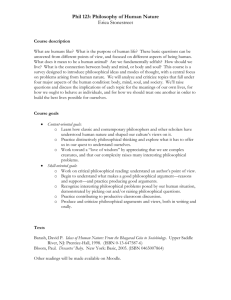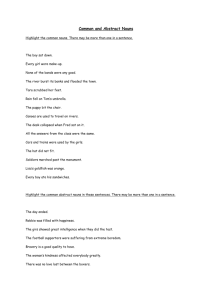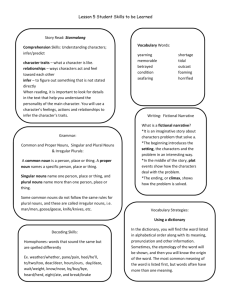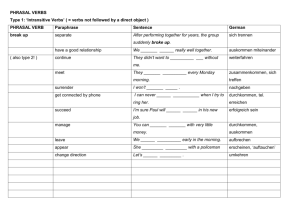Pronouns and anaphors in complex DPs
advertisement
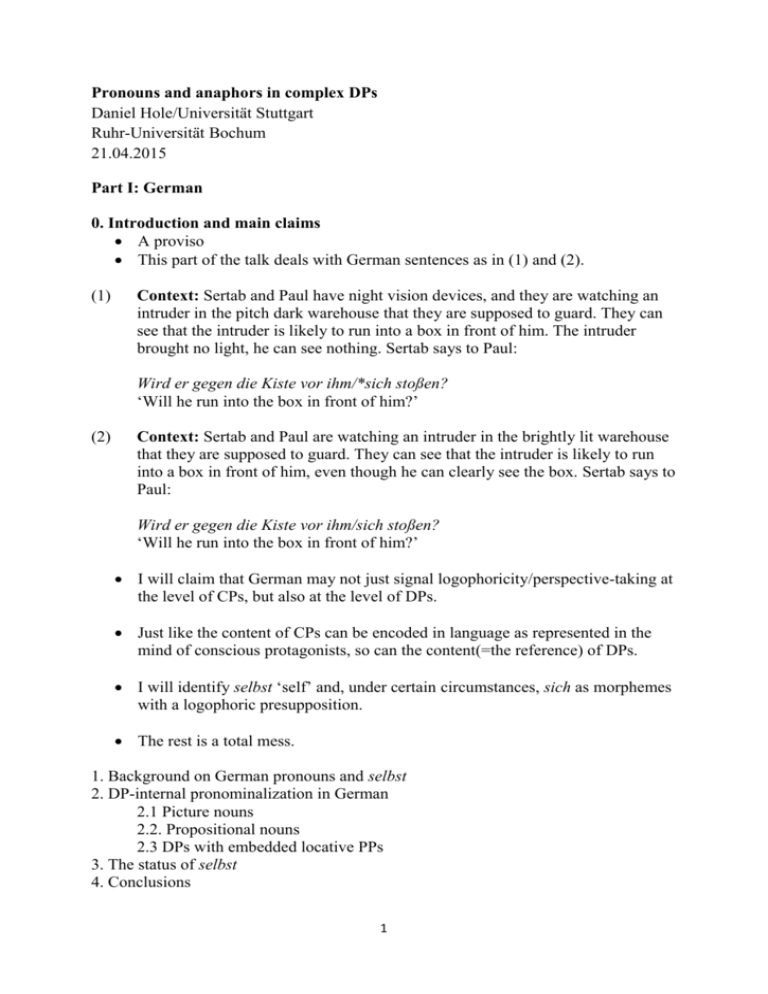
Pronouns and anaphors in complex DPs Daniel Hole/Universität Stuttgart Ruhr-Universität Bochum 21.04.2015 Part I: German 0. Introduction and main claims A proviso This part of the talk deals with German sentences as in (1) and (2). (1) Context: Sertab and Paul have night vision devices, and they are watching an intruder in the pitch dark warehouse that they are supposed to guard. They can see that the intruder is likely to run into a box in front of him. The intruder brought no light, he can see nothing. Sertab says to Paul: Wird er gegen die Kiste vor ihm/*sich stoßen? ‘Will he run into the box in front of him?’ (2) Context: Sertab and Paul are watching an intruder in the brightly lit warehouse that they are supposed to guard. They can see that the intruder is likely to run into a box in front of him, even though he can clearly see the box. Sertab says to Paul: Wird er gegen die Kiste vor ihm/sich stoßen? ‘Will he run into the box in front of him?’ I will claim that German may not just signal logophoricity/perspective-taking at the level of CPs, but also at the level of DPs. Just like the content of CPs can be encoded in language as represented in the mind of conscious protagonists, so can the content(=the reference) of DPs. I will identify selbst ‘self’ and, under certain circumstances, sich as morphemes with a logophoric presupposition. The rest is a total mess. 1. Background on German pronouns and selbst 2. DP-internal pronominalization in German 2.1 Picture nouns 2.2. Propositional nouns 2.3 DPs with embedded locative PPs 3. The status of selbst 4. Conclusions 1 1. Background on German pronouns and selbst German, like most other European languages, has morphologically simplex SE reflexives (Reinhart & Reuland 1993). English has SELF reflexives, i.e. the reflexive pronoun of English has the emphatic particle self conventionally built into it. This contrast leads to more finegrained distinctions in pronominal paradigms of European languages other than English. The exact distribution of some of these pronominal forms has never been investigated (but cf. Kiss 2012). Here’s a first summary of the forms that German has at its disposal. I mostly restrict my attention to the accusative/dative of the third person singular. (I submit that plural forms behave alike, but I haven’t tested that in each case.) PRONOMINAL forms sich forms sich ihn/ihm (msc.) sie/ihr (fem.) es/ihm (ntr.) COMPLEX ihn selbst/ihm selbst (msc.) sich selbst sie selbst/ihr selbst (fem.) es selbst/ihm selbst (ntr.) Table 1: Simplex and selbst-augmented accusative/dative singular 3rd person pronouns of German SIMPLEX In normal argument positions, these selbst-augmented forms don’t do much work. As Eckardt (2001) and Hole (2002a/b, 2008) point out, selbst in them denotes the identity function. Under stress, this makes available relational alternative concepts with an argument slot for the referent of the deaccented pronoun. (3) [About Angela Merkel:] Ich will sie selbst treffen, nicht ihren Sprecher. ? ‘I want to meet her herself, not her speaker.’ (4) [[die Kanzlerin selbst]]=[[selbst]]([[die Kanzlerin]]) = λxe . x(Angela Merkel)=Angela Merkel (5) [[Sprecher der Kanzlerin]]=[[Sprecher]]([[der Kanzlerin]]) λxe . the speaker of x(Angela Merkel)=the speaker of Angela Merkel =Steffen Seibert 2 Selbst augmenting normal pronouns in argument positions does not alter binding relations. (6) Sertabi sah sichi /*[sie (selbst)]i im Spiegel. ‘Sertab saw herself in the mirror.’ (7) Pauli zwickte sichi/*ihn (selbst)i. ‘Paul pinched himself.’ It will be our constant pain in the following sections to determine whether ihn selbst does perspectivizing or reflexivizing work in some environments, or whether we are dealing with more instantiations of the information-structural effect illustrated in (3). 2. DP-internal pronominalization in German 2.1 Picture nouns The situation with selbst-augmented pronouns is different from what we saw above in the complement position of relational nouns if the complement is a variable bound by the local DP or CP subject. Important: all von-PP in this talk are meant to refer to the pictorial content of pictures, they are never meant to refer to possessors/external arguments of picture nouns. (8) a. DP-INTERNAL ANTECEDENT [Paulsi Bild von sichi/ihm selbsti/*ihmi] wurde verkauft. ‘Paul’s picture of himself was sold.’ b. CLAUSAL SUBJECT ANTECEDENT Wird Pauli [das Bild von sichi/ihm selbsti/*ihmi] (ver)kaufen? ‘Will Paul buy/sell the picture depicting himself?’ _______________________________________________________________ c. NO SYNTACTIC ANTECEDENT [Das Bild von *sichi/d.n.a.ihm selbsti/ihmi] hing in Paulsi Wohnzimmer. ‘The picture of himi was hanging in Paul’si living-room.’ In (8c), ihm selbst appears to have the function of making a disfavavored discourse antecedent more easily available for the co-reference resolution of him. Semantically, the identity function will be enough to deliver this. The rest is pragmatics. 3 DP-INTERNAL ANTECEDENT sich ihm ihm selbst CLAUSAL SUBJECT ANTECEDENT NO SYNTACTIC ANTECEDENT * * * d.n.a. Table 2: Pronominalization in N complements (picture nouns) Sich and ihm selbst alternate in binding contexts in complements of picture nouns. (To the best of my knowledge, this is a new descriptive generalization.) 2.2. Propositional nouns With propositional nouns like Gerücht ‘rumor’, Witz ‘joke’ or Geschichte ‘story’, perspectivization kicks in with pronominal complements. Again, to the best of my knowledge, this is a new observation. Let’s begin with examples where all three forms are good. I will return to these examples below. (9) a. Eri war durch [das Gerücht über sichi/ihni/ihn selbsti] überrascht. ‘Paul was surprised about the rumor about himself.’ b. War eri durch [das Gerücht über sichi/ihni/ihn selbsti] überrascht? ‘Was Paul surprised about the rumor about himself?.’ I deliberately chose a psych verb in (9). In (10)-(12) we get to see examples with a non-psych verb. Non-psych verbs do not entail anything about the mental representation of the reported event in a referent that is encoded as one of the arguments of the verb. And here we do get a relevant contrast. (10) [Paul is totally unaware of the fact that there’s this rumor about him that most people know about.] Natürlich wird er durch dieses Gerücht über ihni/*sichi/d.n.a.ihn selbsti geschädigt. ‘Of course hei has disadvantages from this rumor about himi circulating among people.’ Proposition and discourse referent not mentally represented in Paul. (11) [Paul knows very well that there’s this rumor about him that most people know about. And he knows …] [Paul weiß, dass es dieses Gerücht über ihn gibt und dass die meisten Leute es kennen. Und er weiß…] … dass er durch dieses Gerücht über ihni/sichi/ d.n.a.ihn selbsti geschädigt wird.‘…that hei had disadvantages from this rumor about himi circulating among people.’ Proposition and discourse referent mentally represented in Paul. 4 (12) [Paul knows very well that there’s this rumor about him that most people know about. But he doesn’t know …] [Paul weiß, dass es dieses Gerücht über ihn gibt und dass die meisten Leute es kennen. Aber er weiß nicht,…] … dass er durch dieses Gerücht über ihni/sichi/ihn selbsti geschädigt wird. Discourse referent mentally represented in Paul. Proposition not mentally represented in Paul. Terminological convention: If a proposition or discourse referent is mentally represented in a logophoric origo, I speak of CP/DP validation by the origo. CP VALIDATED PROPOSITIONAL DP VALIDATED NO DP/CP VALIDATION sich * ihn ihn selbst d.n.a. Table 3: Pronominalization in N complements (propositional nouns) With propositional nouns and DP or CP validation, DP-internal sich and ihn alternate. Sich is just compatible with DP or CP validation. Ihn is good in all contexts. (To the best of my knowledge, these are new generalization.) 2.3 DPs with embedded locative PPs Our examples from the introduction again (non-propositional DP referent located in space) (13) Context: Sertab and Paul have night vision devices, and they are watching an intruder in the pitch dark warehouse that they are supposed to guard. They can see that the intruder is likely to run into a box in front of him. The intruder brought no light, he can see nothing. Sertab says to Paul: Wird er gegen die Kiste vor ihm/*sich/d.n.a.ihm selbst stoßen? ‘Will he run into the box in front of him?’ (14) Context: Sertab and Paul are watching an intruder in the brightly lit warehouse that they are supposed to guard. They can see that the intruder is likely to run into a box in front of him, even though he can clearly see the box. Sertab says to Paul: Wird er gegen die Kiste vor ihm/sich/dnaihm selbst stoßen? ‘Will he run into the box in front of him?’ 5 LOCATUM DP VALIDATED LOCATUM DP NOT VALIDATED sich * ihm ihm selbst d.n.a d.n.a. Table 4: Pronominalization in DP-internal locative PPs 3. The status of selbst What to do about ihn selbst in our special contexts? option 1: treat all ihn selbst occurrences as normal uses as illustrated in (15) (=(3)) (15) [About Angela Merkel:] Ich will sie selbst treffen, nicht ihren Sprecher. ? ‘I want to meet her herself, not her speaker.’ BUT: there are cases where adding selbst really seems to change grammaticality, and not just felicity. (16) DP-INTERNAL ANTECEDENT [Paulsi Bild von sichi/ihm selbsti/*ihmi] wurde verkauft. ‘Paul’s picture of himself was sold.’ option 2: treat all ihn selbsts as deriving perspectivized nouns, where perspectivization may mean different things. Cf. (17) vs. (18). (17) CLAUSAL SUBJECT ANTECEDENT + PICTURE NOUN (=8b) Wird Pauli [das Bild von sichi/ihm selbsti/*ihmi] (ver)kaufen? ‘Will Paul buy/sell the picture depicting himself?’ (18) DP VALIDATION + PROPOSITIONAL NOUN (=11) [Paul knows very well that there’s this rumor about him that most people know about. And he knows …] [Paul weiß, dass es dieses Gerücht über ihn gibt und dass die meisten Leute es kennen. Und er weiß…] … dass er durch dieses Gerücht über ihni/sichi/ihn selbsti geschädigt wird. ‘Of course hei had disadvantages from this rumor about himi circulating among people.’ BUT: there are cases in which it appears to be so obvious that selbst is used as in runof-the-mill cases. 6 (19) [Paul knows very well that there’s this rumor about him that most people know about. But he doesn’t know …] [Paul weiß, dass es dieses Gerücht über ihn gibt und dass die meisten Leute es kennen. Aber er weiß nicht,…] … dass er durch dieses Gerücht über ihni/sichi/ihn selbsti geschädigt wird. option 3: treat some ihn selbsts as normal uses, and others as doing something else DP-INTERNAL ANTECEDENT sich ihm ihm selbst CLAUSAL SUBJECT ANTECEDENT NO SYNTACTIC ANTECEDENT * * * d.n.a. Table 2’: Pronominalization in N complements (picture nouns) reflexivization: distribution of ihm selbst like sich CP VALIDATED PROPOSITIONAL DP VALIDATED NO DP/CP VALIDATION sich * ihn ihn selbst d.n.a. Table 3’: Pronominalization in N complements (propositional nouns) perspectivization: distribution like sich LOCATUM DP VALIDATED LOCATUM DP NOT VALIDATED sich * ihm ihm selbst () () Table 4’: Pronominalization in DP-internal locative PPs run-of-the-mill: distribution of ihm selbst like ihm (irrelevant) Selbst is like a chameleon. reflexivizer in picture nouns perspectivizer in propositional nouns run-of-the-mill intensifier in DP-internal locative PPs 4. Conclusions Trying to elucidate the distribution of selbst in non-canonical binding contexts of German, I caused a big mess. 7 My intuitions with individual examples tell me that selbst has three functions: (i) reflexivizing (ii) perspectivizing (iii) normal identitity function uses under stress. My intuition as a researcher tells me that this is not a very neat result. But then again, if selbst always denotes the identity function (which amounts to having no truth-conditional meaning at all), then it will be the perfect carrier for presuppositions of different kinds. At least the perspectivizing function may then be said to be lexically parasitic on the identity function in those cases in which we see a perspectivizing function. Hole (2002a) aimed at classifying non-canonical uses of x-self in argument positions in English. (19) Harry watched the Hermione in the pumpkin patch throw the Invisibility Cloak over himself and Ron. He found the following functions: (i) (ii) (iii) (iv) (v) perspectivizing (logophoric/somatophoric) identity function under stress facilitating co-reference with disfavored antecedents enabling appositive readings of like x-self [Even Muggles like yourself/Even Muggles, and you are a Muggle, should be celebrating this happy, happy day!] smoothing out dispreferred phonological patterns (avoids crowding) Maybe it’s worthwhile to go back and compare the two languages even more closely. But we certainly need more corpus data and experimental data. *************************************** HERE’S A POSSIBLE END OF THE TALK. *************************************** 8 Part II: “Unpredictable” self-forms in argument positions in English Hole (2002a) classified exempt anaphors in the Harry Potter corpus (parts I-IV) exhaustively (but not in a mutually exclusive way). The English system is expected to be different from the German one, because English, as said above, incorporates the emphatic/identity function particle into its reflexive anaphor, and because reflexive and pronoun-plus-intensifier end up yielding the same surface form (himself vs. ?*him himself). There is some overlap with the discussion in part I of this talk (but just some). The categories involved are very similar, but their mapping to individual pronominal forms is different. In all cases, -self denotes the identity function. Different use types go along with presuppositions that may have their origins in slightly different variants of the identity function, each of them with a slightly different presuppositional endowment. But I wouldn’t sell my mother for the lexical tie-up that I’m proposing here. Maybe the presuppositions come from somewhere else. 5. Perspectivizing uses: logophoricity and “somatophoricity” a. An unpredictable self-form (exempt anaphor) ensures a perspectivizing reading. I use “FID” (free indirect discourse) and “logophoric contexts” interchangeably. (20) a. Rumours were flying from student to student like highly contagious germs: who was going to try for Hogwarts champion,[…] how the students from Beauxbatons differed from themselves. (HP4:208) b. Harry […] registered one fact: each of these wizards had his wand out, and every wand was pointing right at himself, Ron and Hermione. (HP4:116) There is a rendering of (20a/b) in which us and me (1st person forms) are used instead of themselves and himself. This is the hallmark of logophoricity. Logophoric readings are possible with normal pronouns, too, but they do not force logophoric interpretations. I assume logophoric interpretations as in (20) to be triggered by a logophoric presupposition that –self carries in these contexts. (21) Unpredictable self-forms in logophoric contexts map the relevant referent onto itself inasmuch as it is the logophoric centre. 9 Apart from logophoricity, Hole (2002a) also identifies “somatophoric” uses of self-forms. (22) a Harry and Ron exchanged panic-stricken looks, they threw the Invisibility Cloak back over themselves and retreated into a corner. (hp2:193) b. He [Harry] was still having trouble with the Shield Charm, though. This was supposed to cast a temporary, invisible wall around himself that deflected minor curses. (hp4:529) This notion is supposed to flesh out Sells’ (1987) PIVOT sub-kind of logophoricity. It requires no true logophoricity, but is somehow a local anchoring notion. (23) The goalkeeper could not see the ball because the defending players in the wall were hiding it behind them(*selves). logophoricity mind of a conscious protagonist content of the mind somatophoricity body of a conscious protagonist spatial areas definable in terms of and surrounding the body identity of the referent of the logophoric identity of the referent of the pronoun and the validator somatophoric pronoun and the deictic centre Table 1: Matching the notional ingredients of logophoricity and somatophoricity Hole (2002a: 292) 6. The identity function under stress (canonical adnominal intensification) b. An unpredictable self-form signals adnominal intensification. (24) [] several of Mr. Carmody’s students competed in Kuk Sool Won tournaments in San Francisco and Sacramento […]. As for himself, Mr. Carmody competes regularly in regional tournaments in San Francisco […]. (http://www.hmbksw.com/new/about.html; April 2, 2002) Remember F. X. Toole? His story about a boxing cut-man was one of four firsttimes-in-print last spring. [] As for himself, Toole drove up from Hermosa Beach recently […]. (http://www.webdelsol.com/ZYZZYVA/sp00.note.htm; April 2, 2002) (25) 7. Co-reference with otherwise disfavored antecedents c. An unpredictable self-form ensures co-reference with an otherwise disfavoured antecedent. 10 (26) a. b. (27) a. This was exactly what Harry had been hoping for. He slipped his wand back into his robes, waited until Cedric’s friends had disappeared into their classroom, and hurried up the corridor, which was now empty of everyone except himself and Cedric. (hp4:298) Harry knew Ron had been about to ask about Sirius. [] However, discussing him in front of Ginny was a bad idea. Nobody but themselves [Harry, Hermione, Ron] and Professor Dumbledore knew about how Sirius had escaped, or believed in his innocence. (hp4:55) sect. 6: identity function under stress him[SELF]FOCUS b. or pronoun + [identity function]FOCUS sect. 7 (this section): making accessible antecedents that would be disfavored without -self [himSELF]FOCUS or [pronoun + identity function]FOCUS 8. Restrictive vs. appositive readings with like and such as etc. d. An unpredictable self-form ensures an appositive reading. (28) Even Muggles like yourself should be celebrating, this happy, happy day! (hp1:10) (28’) Even Muggles like you should be celebrating, this happy, happy day! 9. A phonological condition disfavoring self-forms: *CROWDING (24) a. b. Harry and Ron exchanged panic-stricken looks, they threw the Invisibility Cloak back over themselves and retreated into a corner. (hp2:193) […] he [Lucius Malfoy] swung his cloak around him […]. (hp2:249) ********************************************************************* Epilogue: Points of disagreement/clarification needs with Kiss (2012) Semantically, exempt anaphors do allow for binding readings (sloppy identity). Kratzer (2009) is another implementation of reflexivization which creates features of anaphors in the course of the syntactic derivation. The basic word order in OE psych verbs is EXP > STIMULUS (Test: all-new utterances with a single focus accent). Topicalization in German is not LF-active (contra Kiss’s 2012 (13), (23); they are all good). Only exception: no weak-crossover ungrammaticality in German. 11 (20) (21) a Leger gekleidet, mit einem Ferkel im Arm: Dieses Foto von sich gefällt Pater Bednara besonders gut. [Jeden Neffen]i rief seini Onkel an. References Eckardt, Regine (2001). Reanalyzing selbst. Natural Language Semantics 9: 371-412. Hole, D. 2002a. Spell-bound? Accounting for unpredictable self-forms in J.K. Rowling’s Harry Potter stories. Zeitschrift für Anglistik und Amerikanistik 50(3), 285-300. Hole, D. (2002b) ‚Agentive selbst in German’. In: Graham Katz, Sabine Reinhard & Philip Reuter (Hrsg.). Sinn und Bedeutung VI, Proceedings of the sixth meeting of the Gesellschaft für Semantik, Osnabrück, Germany, October, 2001. University of Osnabrück. Hole, D. (2008) ,Focus on identity – the dark side of zìjĭ’. The Linguistic Review 25.3/4, 267-295. Kaiser, E., J. Runner, R. Sussman, M. Tanenhaus. 2009. Structural and semantic constraints on the resolution of pronouns and reflexives. Cognition 112, 55-80. Kiss, T. 2012. Reflexivity and dependency. In: A. Alexiadou, T. Kiss & G. Müller (eds.). Local Modelling of Non-Local Dependencies in Syntax. Berlin/Bosten: de Gruyter Mouton, 155-185. Sells, P. (1987) ‘Aspects of logophoricity’. Linguistic Inquiry 18, 445-479. 12

